Quantifying Uncertainties in Modeling Climate Change Impacts on Hydropower Production
Abstract
:1. Introduction
- Develop a hydroelectricity production model;
- Quantify uncertainties in modeling the impacts of climate change on hydrological properties and hydropower production.
2. Materials and Methods
2.1. Study Area
2.2. Modeling Framework
2.3. Inflow Model Description
2.4. Hydropower Model Development
- S is the reservoir storage at time t (daily in this study) (m3)
- I is the reservoir inflow (m3/s)
- D is the amount of water released out of the reservoir to the turbines (m3/s)
- P is the lake area precipitation (m3)
- E is lake evaporation (m3)
- is power in watts (W).is the dimensionless efficiency of the turbine (taken as 80% of installed capacity).
- is the density of water (kg/m3).
- is the water released to the turbine (m3/s).
- is the acceleration due to gravity (m/s2).
- is the water level above the turbine (reservoir level) (m).
2.5. Observed Data
2.6. Future Projections
2.7. Evaluation and Bias Correction of RCM/GCM Data
3. Results
3.1. Model Calibration
3.2. Projected Trends
3.2.1. Climate
3.2.2. Hydrological Properties of Kainji Lake
3.2.3. Hydropower Production
4. Discussion
5. Conclusions
Acknowledgments
Author Contributions
Conflicts of Interest
References
- Mohammed, Y.S.; Mustafa, M.W.; Bashir, N.; Mokhtar, A.S. Renewable energy resources for distributed power generation in Nigeria: A review of the potential. Renew. Sustain. Energy Rev. 2013, 22, 257–268. [Google Scholar] [CrossRef]
- Abdulkadir, T.S.; Salami, A.W.; Anwar, A.R.; Kareem, A.G. Modelling of hydropower reservoir variables for energy generation: Neural network approach. Ethiop. J. Environ. Stud. Manag. Vol. 2013, 6, 310–316. [Google Scholar] [CrossRef]
- Bartle, A. Hydropower potential and development activities. Energy Policy 2002, 30, 1231–1239. [Google Scholar] [CrossRef]
- Gnansounou, E.; Bayem, H.; Bednyagin, D.; Dong, J. Strategies for regional integration of electricity supply in West Africa. Energy Policy 2007, 35, 4142–4153. [Google Scholar] [CrossRef]
- Ali, A.; Lebel, T. The Sahelian standardized rainfall index revisited. Int. J. Climatol. 2009, 29, 1705–1714. [Google Scholar] [CrossRef]
- Sylla, M.B.; Giorgi, F.; Coppola, E.; Mariotti, L. Uncertainties in daily rainfall over Africa: Assessment of gridded observation products and evaluation of a regional climate model simulation. Int. J. Climatol. 2013, 33, 1805–1817. [Google Scholar] [CrossRef]
- Oyerinde, G.T.; Hountondji, F.C.C.; Wisser, D.; Diekkrüger, B.; Lawin, A.E.; Odofin, A.J.; Afouda, A. Hydro-climatic changes in the Niger basin and consistency of local perceptions. Reg. Environ. Chang. 2015, 15, 1627–1637. [Google Scholar] [CrossRef]
- Druyan, L.M. Studies of 21st-century precipitation trends over West Africa. Int. J. Climatol. 2011, 31, 1415–1424. [Google Scholar]
- Elias, N.N. West Africa Hopes New Hydropower Dams Will Cut Poverty, Climate Risk. Available online: http://news.trust.org//item/20131217125940-0yqo5 (accessed on 27 April 2016).
- Ogilvie, A.; Mahéé, G.; Ward, J.; Serpantiéé, G.; Lemoalle, J.; Morand, P.; Barbier, B.; Kaczan, D.; Lukasiewicz, A.; Paturel, J.; et al. Water, agriculture and poverty in the Niger River basin. Water Int. 2010, 35, 594–622. [Google Scholar] [CrossRef]
- KFW. Adaptation to Climate Change in the Upper and Middle Niger River Basin. Available online: http://ccsl.iccip.net/niger_river_basin.pdf (accessed on 16 June 2016).
- Jimoh, O. Optimized operation of Kainji Reservoir. J. Technol. 2008, 12, 34–42. [Google Scholar]
- Jakeman, A.J.; Littlewood, I.G.; Whitehead, P.G. Computation of the instantaneous unit hydrograph and identifiable component flows with application to two small upland catchments. J. Hydrol. 1990, 117, 275–300. [Google Scholar] [CrossRef]
- Andrews, F.T.; Croke, B.F.W.; Jakeman, A.J. An open software environment for hydrological model assessment and development. Environ. Model. Softw. 2011, 26, 1171–1185. [Google Scholar] [CrossRef]
- Ye, W.; Bates, B.C.; Viney, N.R.; Sivapalan, M. Performance of conceptual rainfall-runoff models in low-yielding ephemeral catchments. Water Resour. Res. 1997, 33, 153–166. [Google Scholar] [CrossRef]
- Andrews, F. ARMAX Transfer Function Models. Available online: http://hydromad.catchment.org/man/armax.html (accessed on 30 March 2016).
- Dutta, D.; Welsh, W.; Vaze, J.; Kim, S.; Nicholls, D. Improvement in short-term streamflow forecasting using an integrated modelling framework. In Proceedings of 19th International Congress on Model and Simulation, Perth, WA, Australia, 12–16 December 2011.
- Jakeman, A.; Hornberger, G. How much complexity is warranted in a rainfall-runoff model? Water Resour. Res. 1993, 29, 2637–2649. [Google Scholar] [CrossRef]
- Andrews, F. IHACRES Catchment Wetness Index (CWI) Model. Available online: http://hydromad.catchment.org/man/IHACRES.CWI.model.html (accessed on 31 May 2016).
- Nash, J.E.; Sutcliffe, J.V. River flow forecasting through conceptual models part I—A discussion of principles. J. Hydrol. 1970, 10, 282–290. [Google Scholar] [CrossRef]
- Legates, D.R.; McCabe, G.J. Evaluating the use of “goodness-of-fit” measures in hydrologic and hydroclimatic model validation. Water Resour. Res. 1999, 35, 233–241. [Google Scholar] [CrossRef]
- Krause, P.; Boyle, D.; Bäse, F. Comparison of different efficiency criteria for hydrological model assessment. Adv. Geosci. 2005, 5, 89–97. [Google Scholar] [CrossRef]
- Kling, H.; Fuchs, M.; Paulin, M. Runoff conditions in the upper Danube basin under an ensemble of climate change scenarios. J. Hydrol. 2012, 424–425, 264–277. [Google Scholar] [CrossRef]
- Proussevitch, A.; Shiklomanov, A.; Frolking, S.; Glidden, S.; Lammers, R.; Wisser, D. Log-Exponential Reservoir Operating Rules for Global and Regional Hydrological Modeling. Available online: http://posters.unh.edu/media/uploads/originals/2013/12/05/2013-12_Fall_AGU.Dams.pdf (accessed on 30 March 2016).
- Hirsch, P.E.; Schillinger, S.; Weigt, H.; Burkhardt-holm, P. A hydro-economic model for water level fluctuations: Combining limnology with economics for sustainable development of hydropower. PLoS ONE 2014, 9, 1–26. [Google Scholar] [CrossRef] [PubMed]
- Paish, O. Small hydro power: Technology and current status. Renew. Sustain. Energy Rev. 2002, 6, 537–556. [Google Scholar] [CrossRef]
- Huffman, G.J.; Adler, R.F.; Arkin, P.; Chang, A.; Ferraro, R.; Gruber, A.; Janowiak, J.; Mcnab, A.; Rudolf, B.; Schneider, U. The Global Precipitation Climatology Project (GPCP) combined precipitation dataset. Bull. Am. Meteorol. Soc. 1997, 78, 5–20. [Google Scholar] [CrossRef]
- Rienecker, M.M.; Suarez, M.J.; Gelaro, R.; Todling, R.; Bacmeister, J.; Liu, E.; Bosilovich, M.G.; Schubert, S.D.; Takacs, L.; Kim, G.-K.; et al. MERRA: NASA’s modern-era retrospective analysis for research and applications. J. Clim. 2011, 24, 3624–3648. [Google Scholar] [CrossRef]
- Jobard, I.; Chopin, F.; Berges, J.C.; Roca, R. An intercomparison of 10-day satellite precipitation products during West African monsoon. Int. J. Remote Sens. 2011, 32, 2353–2376. [Google Scholar] [CrossRef]
- Gosset, M.; Viarre, J. Evaluation of several rainfall products used for hydrological applications over West Africa using two high-resolution gauge networks. Q. J. R. Meteorol. Soc. 2013, 139, 923–940. [Google Scholar] [CrossRef]
- Negrón Juárez, R.I.; Li, W.; Fu, R.; Fernandes, K.; de Oliveira Cardoso, A. Comparison of precipitation datasets over the tropical South American and African continents. J. Hydrometeorol. 2009, 10, 289–299. [Google Scholar] [CrossRef]
- Oudin, L.; Hervieu, F.; Michel, C.; Perrin, C.; Andréassian, V.; Anctil, F.; Loumagne, C. Which potential evapotranspiration input for a lumped rainfall-runoff model? J. Hydrol. 2005, 303, 290–306. [Google Scholar] [CrossRef]
- Lehner, B.; Verdin, K.; Jarvis, A. New global hydrography derived from spaceborne elevation data. EOS Trans. Am. Geophys. Union 2008, 89, 93–94. [Google Scholar] [CrossRef]
- Jasiewicz, J.; Metz, M. A new GRASS GIS toolkit for Hortonian analysis of drainage networks. Comput. Geosci. 2011, 37, 1162–1173. [Google Scholar] [CrossRef]
- Lucio, P.; Molion, L.; Valadão, C.; Conde, F.; Ramos, A.; Mld, M. Dynamical outlines of the rainfall variability and the ITCZ role over the West Sahel. Atmos. Clim. Sci. 2012, 2, 337–350. [Google Scholar] [CrossRef]
- Giorgi, F.; Jones, C.; Asrar, G.R. Addressing climate information needs at the regional level: The CORDEX framework. WMO Bull. 2009, 58, 175–183. [Google Scholar]
- Taylor, K.E.; Stouffer, R.J.; Meehl, G.A. An overview of CMIP5 and the experiment design. Bull. Am. Meteorol. Soc. 2012, 93, 485–498. [Google Scholar] [CrossRef]
- Ravazzani, G.; Dalla Valle, F.; Gaudard, L.; Mendlik, T.; Gobiet, A.; Mancini, M. Assessing climate impacts on hydropower production: The case of the Toce River Basin. Climate 2016, 4. [Google Scholar] [CrossRef] [Green Version]
- Maraun, D. Bias correction, quantile mapping, and downscaling: Revisiting the inflation issue. J. Clim. 2013, 26, 2137–2143. [Google Scholar] [CrossRef]
- Sylla, M.B.; Giorgi, F.; Pal, J.S.; Gibba, P.; Kebe, I.; Nikiema, M. Projected changes in the annual cycle of high intensity precipitation events over West Africa for the late 21st century. J. Clim. 2015, 28, 6475–6488. [Google Scholar] [CrossRef]
- Rufai, I.A.; Enagi, I.I.; Balami, A.A. Hydropower potential mapping of Niger state. Asian J. Nat. Appl. Sci. 2012, 1, 46–53. [Google Scholar]
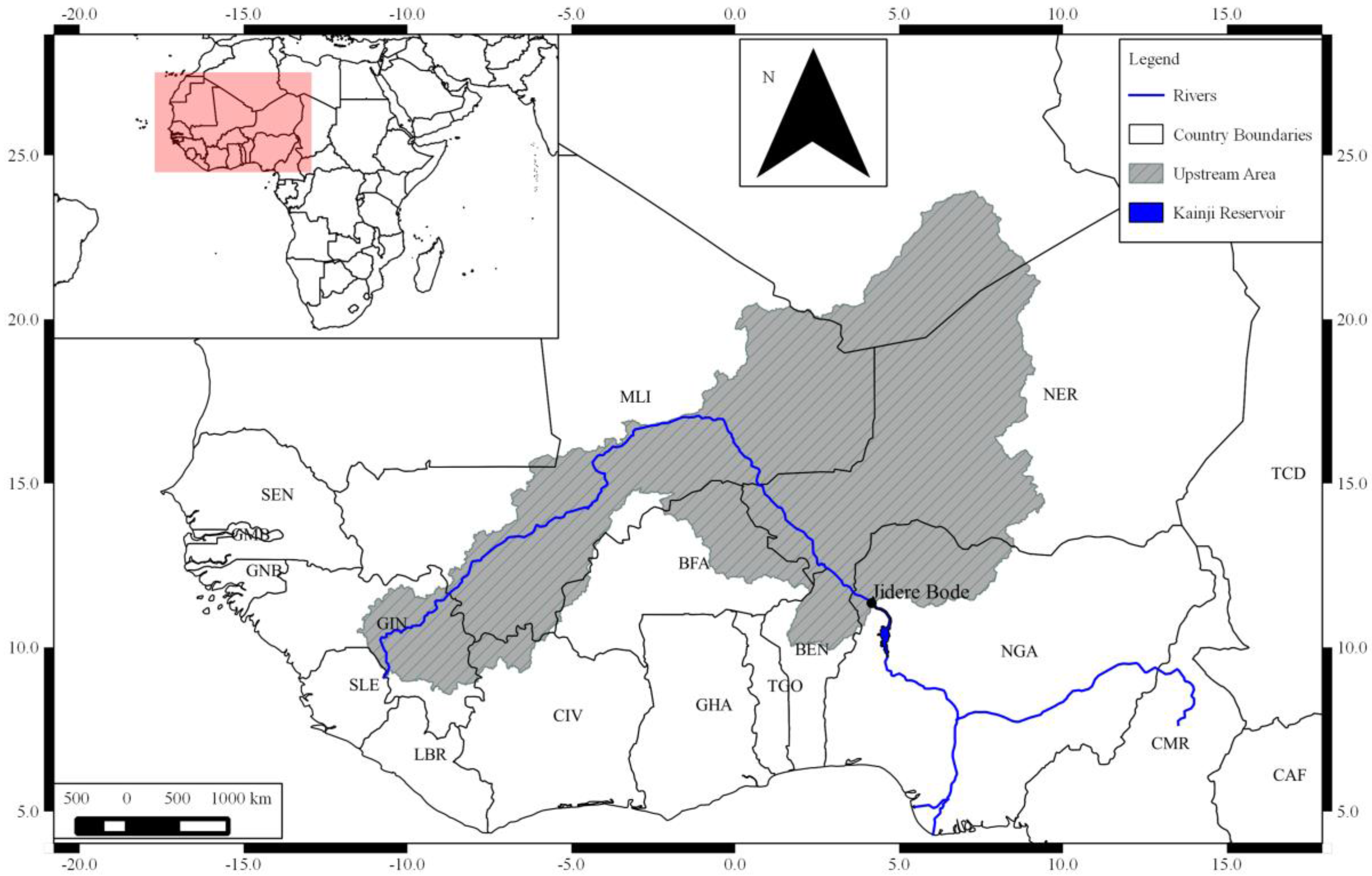
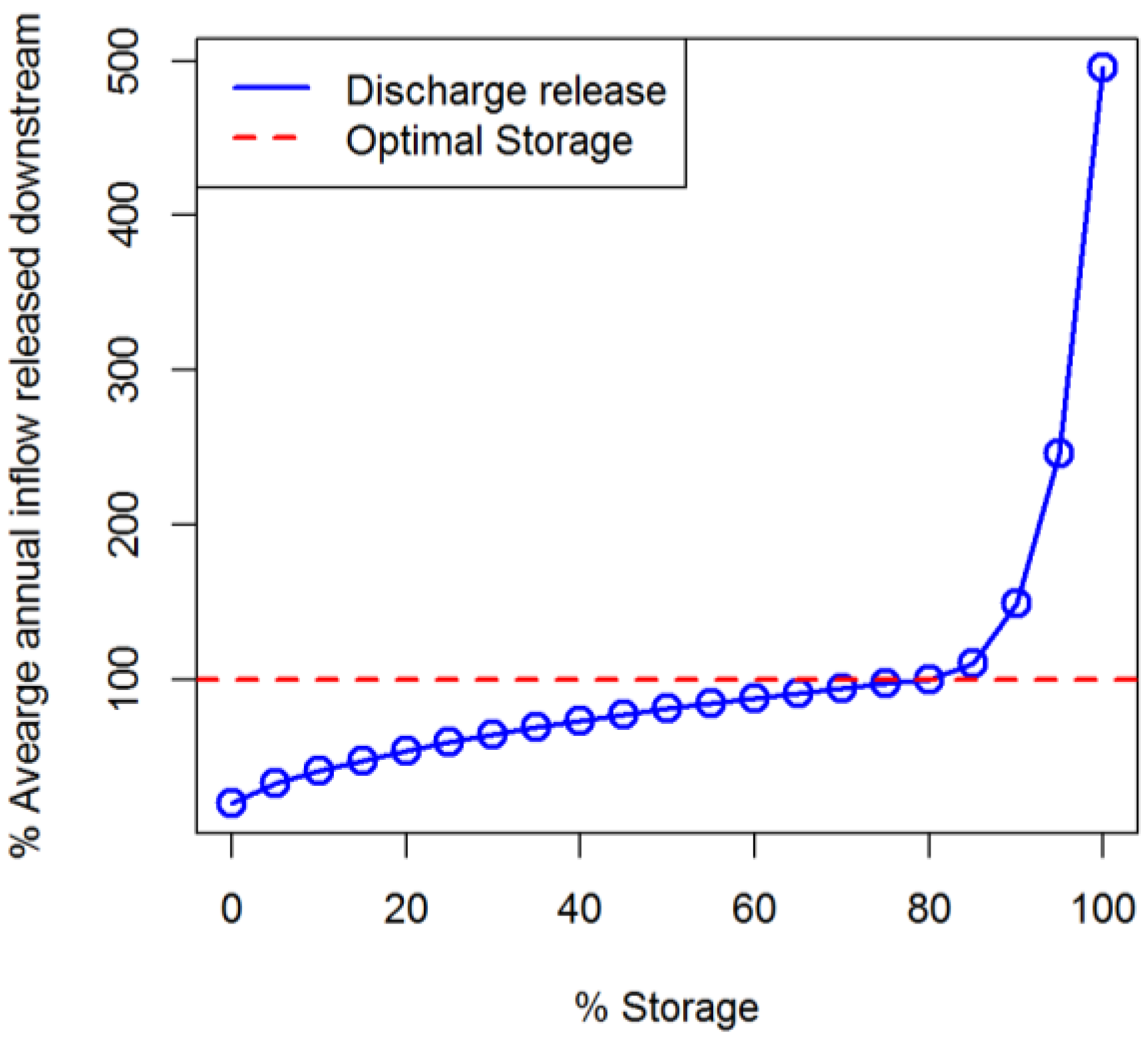
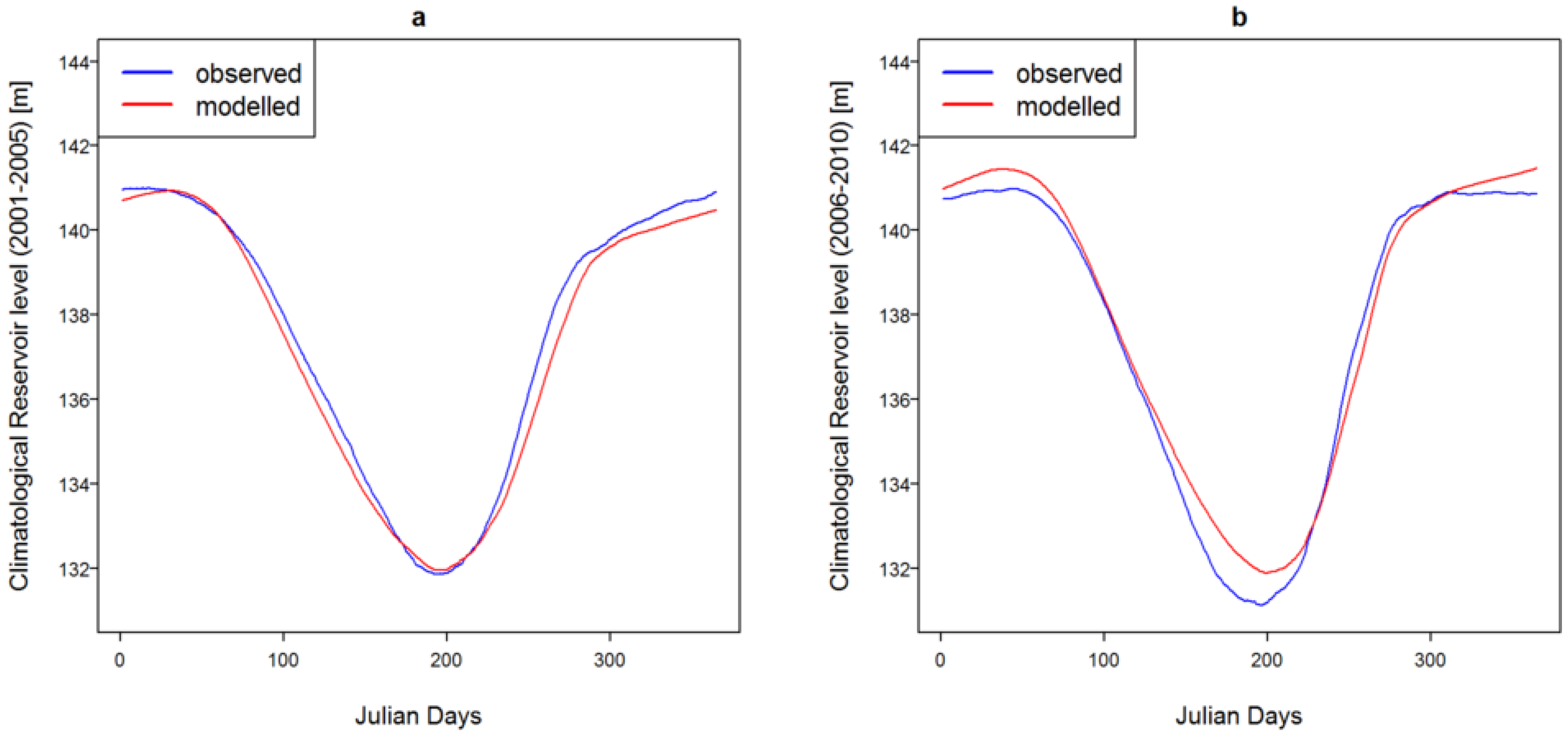

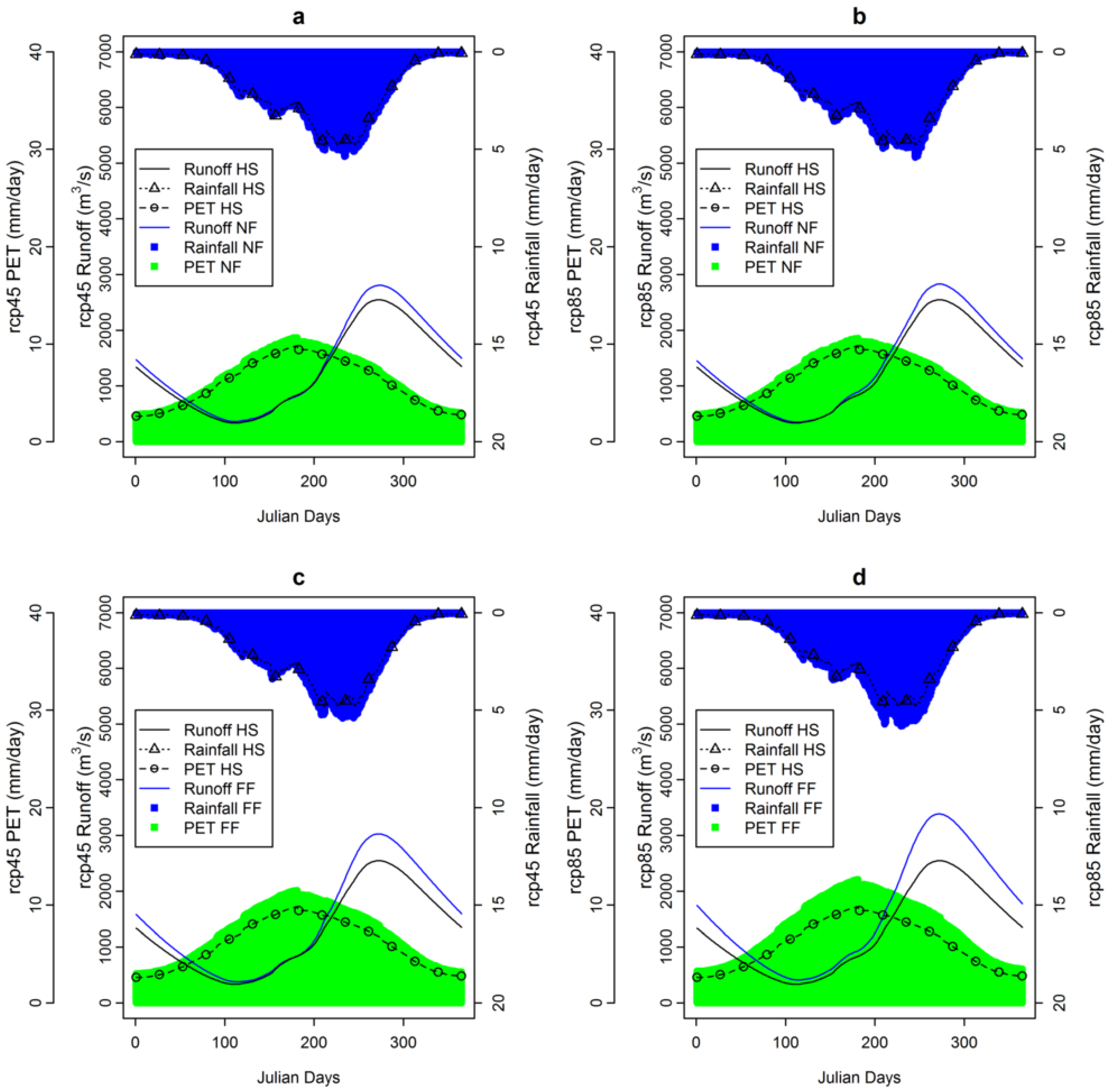

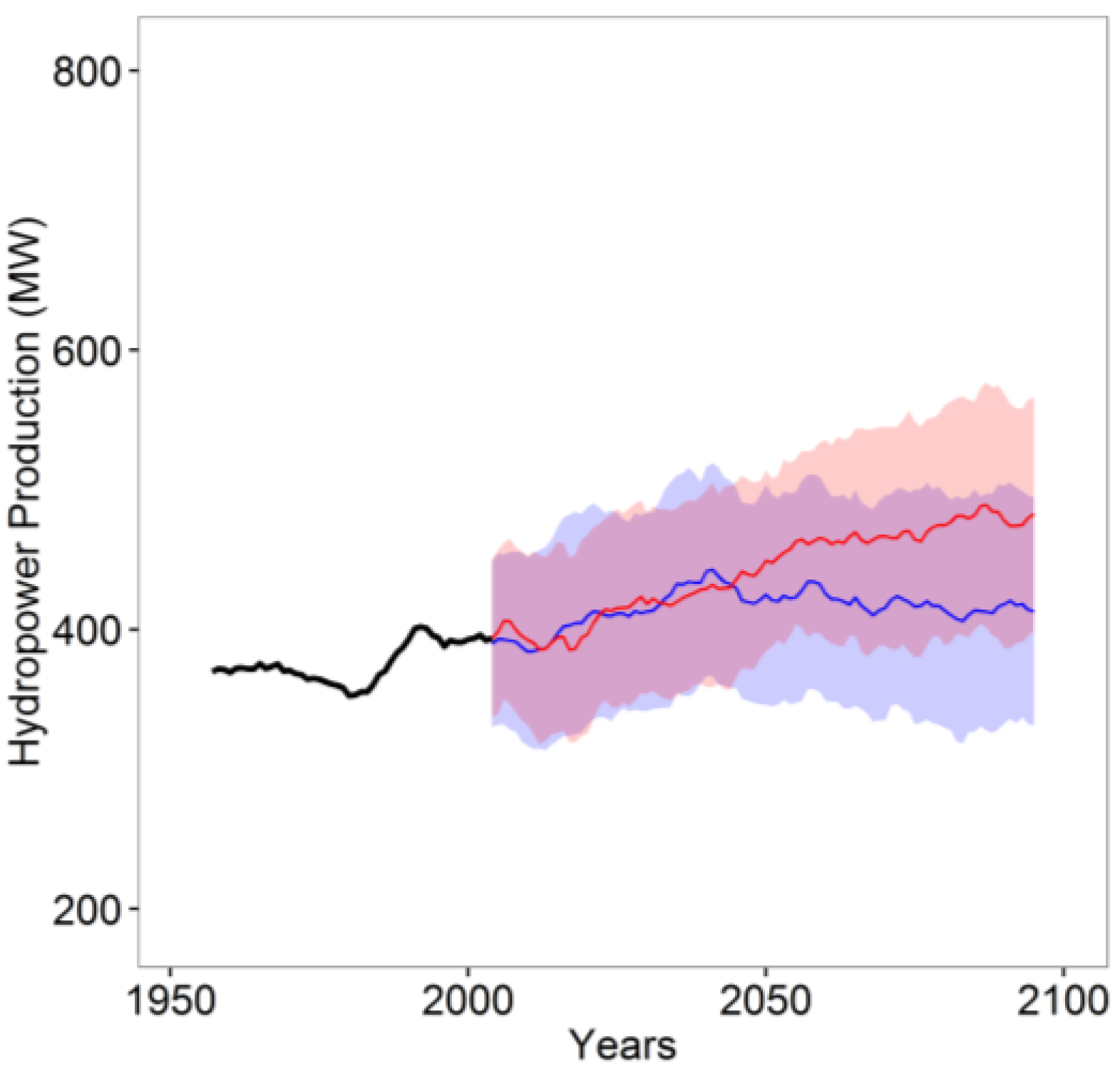
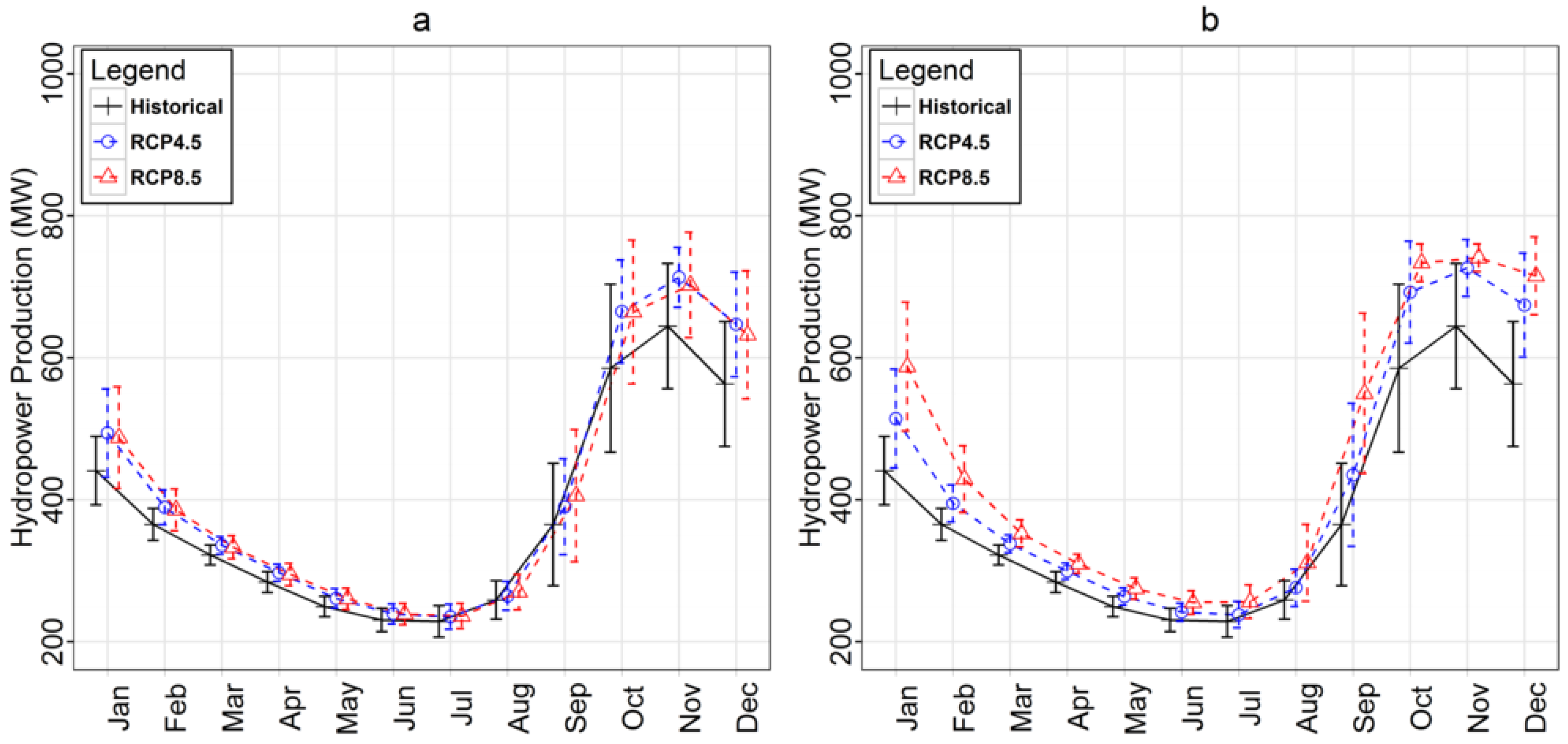
| Modeling Center (or Group) | Institute ID | Model Name |
|---|---|---|
| Canadian Centre for Climate Modeling and Analysis | CCCMA | CanESM2 |
| Centre National de Recherches Météorologiques/Centre Européen de Recherche et Formation Avancée en Calcul Scientifique | CNRM-CERFACS | CNRM-CM5 |
| NOAA Geophysical Fluid Dynamics Laboratory | NOAA GFDL | GFDL-ESM2M |
| Met Office Hadley Centre (additional HadGEM2-ES realizations contributed by Instituto Nacional de Pesquisas Espaciais) | MOHC | HadGEM2-ES |
| Atmosphere and Ocean Research Institute (The University of Tokyo), National Institute for Environmental Studies, and Japan Agency for Marine-Earth Science and Technology | MIROC | MIROC5 |
| Max-Planck-Institut für Meteorologie (Max Planck Institute for Meteorology) | MPI-M | MPI-ESM-LR |
| Norwegian Climate Centre | NCC | NorESM1-M |
| EC-EARTH consortium | EC-EARTH | EC-EARTH |
| MODELS | Rainfall (%) | PET (%) | Hydropower (%) | |||||||||
|---|---|---|---|---|---|---|---|---|---|---|---|---|
| NF | FF | NF | FF | NF | FF | |||||||
| RCP 45 | RCP 85 | RCP 45 | RCP 85 | RCP 45 | RCP 85 | RCP 45 | RCP 85 | RCP 45 | RCP 85 | RCP 45 | RCP 85 | |
| CanESM2 | 5.26 | 6.45 | 9.11 | 18.37 | 9.82 | 11.33 | 20.28 | 34.19 | 9.77 | 9.95 | 17.28 | 28.86 |
| CNRM-CM5 | 0.28 | 2.35 | 5.17 | 14.02 | 6.21 | 6.58 | 13.41 | 22.66 | −1.47 | −0.69 | 5.33 | 18.46 |
| EC-EARTH | 0.44 | −1.57 | 3.69 | 6.43 | 7.82 | 8.53 | 15.88 | 27.22 | −0.90 | −4.22 | 2.35 | 5.67 |
| MIROC5 | 11.19 | 10.15 | 15.19 | 28.57 | 9.58 | 9.93 | 17.65 | 28.09 | 29.06 | 23.30 | 32.84 | 48.24 |
| HadGEM2-ES | 6.97 | 8.80 | 4.93 | 9.59 | 8.98 | 10.89 | 21.49 | 35.81 | 15.68 | 18.17 | 16.97 | 25.55 |
| MPI-ESM-LR | −0.75 | 3.29 | −1.55 | 3.38 | 7.85 | 8.46 | 15.94 | 28.91 | 1.84 | 5.44 | -0.40 | 6.82 |
| NorESM1-M | 4.01 | 4.77 | 7.67 | 12.91 | 7.24 | 8.14 | 15.32 | 23.98 | 6.81 | 8.43 | 13.58 | 20.23 |
| GFDL-ESM2M | 2.92 | 5.35 | 6.19 | 9.32 | 9.58 | 9.66 | 15.32 | 26.20 | 4.43 | 5.05 | 8.57 | 8.46 |
| ENSMED | 4.17 | 4.10 | 5.87 | 13.28 | 8.43 | 9.32 | 16.77 | 27.87 | 8.72 | 8.63 | 12.81 | 24.00 |
© 2016 by the authors; licensee MDPI, Basel, Switzerland. This article is an open access article distributed under the terms and conditions of the Creative Commons Attribution (CC-BY) license (http://creativecommons.org/licenses/by/4.0/).
Share and Cite
Oyerinde, G.T.; Wisser, D.; Hountondji, F.C.C.; Odofin, A.J.; Lawin, A.E.; Afouda, A.; Diekkrüger, B. Quantifying Uncertainties in Modeling Climate Change Impacts on Hydropower Production. Climate 2016, 4, 34. https://doi.org/10.3390/cli4030034
Oyerinde GT, Wisser D, Hountondji FCC, Odofin AJ, Lawin AE, Afouda A, Diekkrüger B. Quantifying Uncertainties in Modeling Climate Change Impacts on Hydropower Production. Climate. 2016; 4(3):34. https://doi.org/10.3390/cli4030034
Chicago/Turabian StyleOyerinde, Ganiyu Titilope, Dominik Wisser, Fabien C.C. Hountondji, Ayo J. Odofin, Agnide E. Lawin, Abel Afouda, and Bernd Diekkrüger. 2016. "Quantifying Uncertainties in Modeling Climate Change Impacts on Hydropower Production" Climate 4, no. 3: 34. https://doi.org/10.3390/cli4030034






